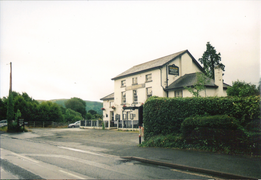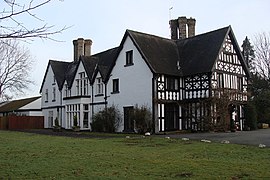Caersws
Caersws
| |
|---|---|
 The former village church | |
Location withinPowys | |
| Population | 1,586(2011) |
| OS grid reference | SO031919 |
| Community |
|
| Principal area | |
| Preserved county | |
| Country | Wales |
| Sovereign state | United Kingdom |
| Post town | Caersws |
| Postcode district | SY17 |
| Dialling code | 01650 |
| Police | Dyfed-Powys |
| Fire | Mid and West Wales |
| Ambulance | Welsh |
| UK Parliament | |
| Senedd Cymru – Welsh Parliament | |
Caersws(Welsh:Caersŵs;pronounced[kɑːɨrˈsuːs]) is a village andcommunityon theRiver Severn,in theWelshcounty ofPowys(Montgomeryshire) 5 miles (8 km) west ofNewtown,and halfway betweenAberystwythandShrewsbury.It has astationon theCambrian LinefromAberystwythtoShrewsbury.At the 2011 Census, the community had a population of 1,586[1]– a figure which includes the settlements ofClatter,LlanwnnogandPontdolgoch.The village itself had a population of slightly over 800.[2]
Etymology
[edit]The name is derived from the Welsh placename elements "Caer- "and" Sŵs "." Caer "translates as" fort "and likely refers to theRoman settlement.The derivation of the second element is less certain.
Thomas Pennantand later writers note that the fort was the termination of theRoman RoadfromChester(viaMeifod), the name of the road wasSarn SwsanorSarn Swsogand it is thought that the town and the road share their etymology. The meaning of Swsan/Swsog is again, uncertain, but two local traditions hold that this is a personal name, either of a Queen Swswen (a name which may translate as "The Blessed/Pure Kiss" ) a Celtic leader who is said to have fought a battle in the vicinity around the time of theRoman occupationwho was equated withEstrildisbyOliver Mathews,[3]or it is named for a Roman lieutenant "Hesus".[4][5][6]
Furthermore, the linguistJohn Rhysnoted that the dialect of Mid-Wales Welsh (Y Bowyseg) was closer to theGaulish languagethan its neighbours, and concluded that the area had pre-Roman links to Gaul. This may suggest a link between Caersŵs and the GodEsusvenerated by theParisiiandTreverii.[7][8]
Other suggested etymologies include the name retaining a Roman-era dedication toZeus,and the fact that "sws" (not sŵs) can be literally translated to "Kiss"inmodern Welshhas led to a number of developingfolk etymologies.
History
[edit]Caersws was the location of twoRoman fortsofRoman Wales.Although theMediolanumof theAntonine Itineraryhas since been identified asWhitchurchinShropshire,Caersws is sometimes identified as the Mediolanum among theOrdovicesdescribed inPtolemy'sGeography,[9]although others argue forLlanfyllin[10]orMeifod.[10][11]Further, this second Mediolanum may be identical or distinct from the "Mediomanum" (lit."Central Hand" ) mentioned by theRavenna Cosmography.[9]
Governance
[edit]Anelectoral wardin the same name exists. This ward includes the community ofCarnoand at the 2011 Census had a population of 2,316.[12]
Buildings
[edit]The Church of St Gwynog dates from the 15th century and was restored in 1863. It contains a 15th centuryrood screenand loft which theRoyal Commission on the Ancient and Historical Monuments of Walesdescribes as "exceptional; the best-preserved of thirty known to have existed in the county".[13]Maesmawr Hall,to the south-east of the village, was built in the early 19th century and is aGrade II* listed building.[14]
Sport
[edit]DownhillMountain Bikinghas flourished in forestry at Henblas farm, to the north of the village, with a number of national races being held there. The current series - The Caersws Cup[15]- began in March 2009.
Cymru AllianceclubCaersws F.C.are based in the village, and play their home matches at theRecreation Ground.
Caersws is home to current and past champions of a number of sporting disciplines, leading some to christen it the "Sporting Capital of Wales".[16]
Notable people
[edit]- John Ceiriog Hughes(1832–1887), a Welsh poet and collector of Welsh folk tunes; also stationmaster and manager of theVan Railwayfrom 1868 to 1887; buried in the churchyard atLlanwnnog.
- Mart Watkins(1880–1942), footballer with 161 club caps and 10 forWales.
- Derek A. Traversi(1912–2005), a literary critic mainly for theBritish Council
- Phil Woosnam(1932–2013), formerNASLcommissioner and footballer with over 370 club caps and 17 forWales.
Gallery
[edit]-
One of Caersws’ four localpubsin 2010.
-
The in townlevel crossingby theCaersws stationin 2010.
-
A gated village Barrow Crossing/foot crossing in Caersws in 2010.
-
Maesmawr Hall,a grade II* listed building
See also
[edit]References
[edit]- ^"Community population 2011".Archived fromthe originalon 4 March 2016.Retrieved10 November2015.
- ^"Local Area Report for Caersws Built-up area (based on 2011 Census)".Nomis - Official Labour Market Statistics.Archivedfrom the original on 5 November 2020.Retrieved6 April2022.
- ^Morris, Rupert,ed. (1911).Parochialia.Archaeologia Cambrensis.Vol. 3. London:Cambrian Archaeological Association.p. 99.
- ^Eddowes, John (1832).The History of Wales; Written originally in British by Caradoc of Llancarvan; Translated into English by Dr. Powell.Shrewsbury. pp. 283–284.Archivedfrom the original on 6 April 2022.Retrieved7 December2020.
- ^Knight, C. (1839).The Penny Cyclopædia of the Society for the Diffusion of Useful Knowledge(Volume 15 ed.). London. p. 363.Archivedfrom the original on 6 April 2022.Retrieved7 December2020.
- ^Lewis, Samuel (1840).A Topographical Dictionary of Wales: Comprising the Several Counties, Cities, Boroughs, Corporate and Market Towns, Parishes, Chapelries, and Townships, with Historical and Statistical Descriptions (Volume 1)(2nd ed.). London.
- ^Williams, E. W. (30 April 2015)."J.E.Lloyd and his intellectual legacy; the tribes of Wales reconsidered"(PDF):203.Archived(PDF)from the original on 6 April 2022.Retrieved1 April2020.
{{cite journal}}:Cite journal requires|journal=(help) - ^Rhys J. & Brynmor-Jones D.The Welsh People.London: Unwin. pp. 19–21.
- ^abRoman Britain Organisation."Mediomanum?" atRoman BritainArchived2007-04-01 at theWayback Machine.2010.
- ^abWilliams, Robert."A History of the Parish of Llanfyllin" inCollections Historical & Archaeological Relating to Montgomeryshire,Vol. III, p. 59Archived22 December 2016 at theWayback Machine.J. Russell Smith (London), 1870.
- ^Newman, John Henry & al.Lives of the English Saints: St. German, Bishop of Auxerre,Ch. X: "Britain in 429, A. D.", p. 92.Archived2016-03-21 at theWayback MachineJames Toovey (London), 1844.
- ^"Ward population 2011".Archivedfrom the original on 26 September 2020.Retrieved10 November2015.
- ^"St Gwynog's Church, Llanwnog (146172)".Coflein.RCAHMW.Retrieved25 January2024.
- ^Cadw."Maesmawr Hall (Grade II*) (7572)".National Historic Assets of Wales.Retrieved25 January2024.
- ^"Archived copy".Archived fromthe originalon 27 August 2009.Retrieved22 July2009.
{{cite web}}:CS1 maint: archived copy as title (link) - ^"Sporty Village Boasts Famous Five at BBC.co.uk".28 December 2008.Archivedfrom the original on 31 December 2008.Retrieved28 December2008.
Literature
[edit]- Stephenson D. (2014),The Medieval Borough of Caersws: Origins and Decline,The Montgomeryshire Collections, Vol. 102, 103–109.
External links
[edit]- 6 pages of artifacts and documents associated with Caersws and held on Gathering the Jewels the website of Welsh cultural history[permanent dead link]
- geograph.co.uk: photos of Caersws and surrounding area







